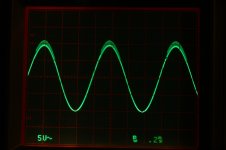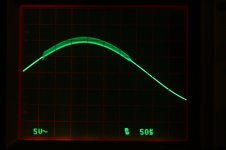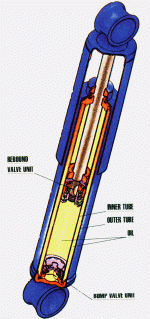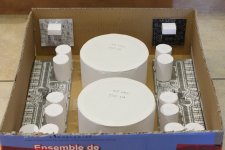Oscillation Issues
I have completed my second amp using all original component values except 4 pairs of outputs instead of 5. This one shows parasitic oscillations at the positive peaks of a 1 Khz sine wave. (see attachments). The parasitics don't appear until the output is approximately 20 v. peak into 8 ohm resistive load. Bias level has no effect from 1 mv to 28 mv across a single emitter resistor. Has anyone else besides Carlos actually looked at their amps output on a scope? I'm very curious about whether this result is unique.
Steve
Mine was rock stable....are there more guys facing troubles?
CDom should be increased! ....the value posted is the smallest possible value...i have tried 82pf, 100pf, 120pf and 150pf .... checking mine i found the value you may see.
56pf is a big risk..... i cannot understand why i have not mentioned that....haven't i mentioned this before in this thread?
regards,
Carlos
I have completed my second amp using all original component values except 4 pairs of outputs instead of 5. This one shows parasitic oscillations at the positive peaks of a 1 Khz sine wave. (see attachments). The parasitics don't appear until the output is approximately 20 v. peak into 8 ohm resistive load. Bias level has no effect from 1 mv to 28 mv across a single emitter resistor. Has anyone else besides Carlos actually looked at their amps output on a scope? I'm very curious about whether this result is unique.
Steve
Attachments
Last edited:
First schematic posted suggested 56pf dear A Wayne
This was a mistake..it was the smallest, the minimum possible value i have tried in my prototype that made (result) the amplifier stable.
When we discover the minimum value...we go 2 steps higher.... 56pf goes to 68 and then 82pf.....so...the more safe, or less unsafe value is 82pf or more.... i am using 220pf in my home.
The first schematic that was posted in the Hx thread shown the mistake...their you see the capacitor indication is 56pf..... this is not safe Wayne...it is too small....it can work or not... this is a risk the designer does to know the threshold...knowing the real life threshold we go to higher values...at least 2 steps higher...i use to go three or four and even five.
What steps?...the capacitor values...tradicionaly starting with 27pf we have 33pf, 39pf, 47pf, 56pf, 68pf, 82pf, 100pf, 120pf,150pf,180pf, 220pf, 270pf, 330pf, 390pf and so on.
This way i suggest people to increase if using small values.... 150pf, 180pf and 220pf are the best ones to be in the safe side without bother about cats and dogs, bats and other animals that will listen distorted tones filled with harmonics.
Got it?...what is your mother language?, i can send you an audio message in your mother language if you want it...explaining the stuff better...just gimme your email adress or write to nanabrother@yahoo.com.
If someone is using 56pf, there are two possibilities...the guy is having oscilations or he is not having oscilations (i had not but i could see that 47pf oscilated a lot!)...so, at my home 56pf whas the minimum, smallest value that we can try...WE... researchers, designers or suiciders...... if you go to higher values than the minimum detected value..then you have no oscilations and the "oscilation" danger is avoided.
this stuff controls distortion into high frequencies and slew rate..usually for measurements only, because we do not listen (but we perceive that something is in the air) above 20 kilohertz..and these tests are made above this frequency.
Want a safe amplifier that will be listened by humans without any distorted high frequency waveform within the audible limits for human beings..then use 220pf...want to face some risks..then go to 180pf...if you have courage then go to 150pf...if you are trying to be friend of the devil, then go to 120pf...if you hate your mother you go to 100pf....if you love to face troubles, then try 82pf .... if you have scaped from a mad house, then try 68pf....if you want to check if amplifier can be destructed, then go to 56pf as the designer made...to be sure the minimum value that drives the amplifier into oscilations..this value is not to suggest...this value is the reference of minimum possible values to be applied...then we go higher to be in the safe side..... and i forgot to change that.
When you increase the capacitor, then you start to have distorted sinusoidal waveforms when you input them into your amplifier..this means other waveforms will be distorted too...but this happens only to high frequencies..and this much higher than humans can listen..so..it is for cats and dogs.... do not bother to use 220pf.... within your limits of audition the waveform will be good...but cats and dogs will be angry and a simulator will show a very bad waveform of 100 kilohertz.
I hope people is not building the first schematic published in the MKIII Hx thread....got it?
regards,
Carlos
This was a mistake..it was the smallest, the minimum possible value i have tried in my prototype that made (result) the amplifier stable.
When we discover the minimum value...we go 2 steps higher.... 56pf goes to 68 and then 82pf.....so...the more safe, or less unsafe value is 82pf or more.... i am using 220pf in my home.
The first schematic that was posted in the Hx thread shown the mistake...their you see the capacitor indication is 56pf..... this is not safe Wayne...it is too small....it can work or not... this is a risk the designer does to know the threshold...knowing the real life threshold we go to higher values...at least 2 steps higher...i use to go three or four and even five.
What steps?...the capacitor values...tradicionaly starting with 27pf we have 33pf, 39pf, 47pf, 56pf, 68pf, 82pf, 100pf, 120pf,150pf,180pf, 220pf, 270pf, 330pf, 390pf and so on.
This way i suggest people to increase if using small values.... 150pf, 180pf and 220pf are the best ones to be in the safe side without bother about cats and dogs, bats and other animals that will listen distorted tones filled with harmonics.
Got it?...what is your mother language?, i can send you an audio message in your mother language if you want it...explaining the stuff better...just gimme your email adress or write to nanabrother@yahoo.com.
If someone is using 56pf, there are two possibilities...the guy is having oscilations or he is not having oscilations (i had not but i could see that 47pf oscilated a lot!)...so, at my home 56pf whas the minimum, smallest value that we can try...WE... researchers, designers or suiciders...... if you go to higher values than the minimum detected value..then you have no oscilations and the "oscilation" danger is avoided.
this stuff controls distortion into high frequencies and slew rate..usually for measurements only, because we do not listen (but we perceive that something is in the air) above 20 kilohertz..and these tests are made above this frequency.
Want a safe amplifier that will be listened by humans without any distorted high frequency waveform within the audible limits for human beings..then use 220pf...want to face some risks..then go to 180pf...if you have courage then go to 150pf...if you are trying to be friend of the devil, then go to 120pf...if you hate your mother you go to 100pf....if you love to face troubles, then try 82pf .... if you have scaped from a mad house, then try 68pf....if you want to check if amplifier can be destructed, then go to 56pf as the designer made...to be sure the minimum value that drives the amplifier into oscilations..this value is not to suggest...this value is the reference of minimum possible values to be applied...then we go higher to be in the safe side..... and i forgot to change that.
When you increase the capacitor, then you start to have distorted sinusoidal waveforms when you input them into your amplifier..this means other waveforms will be distorted too...but this happens only to high frequencies..and this much higher than humans can listen..so..it is for cats and dogs.... do not bother to use 220pf.... within your limits of audition the waveform will be good...but cats and dogs will be angry and a simulator will show a very bad waveform of 100 kilohertz.
I hope people is not building the first schematic published in the MKIII Hx thread....got it?
regards,
Carlos
Last edited:
Awfull waveform Bonfis
This is not normal..... are you using big condensers (size) in your input?... please, post pictures.
Was this test made using speakers or resistive load (dummy load)...have your tried to unstabilize using capacitor in paralel with the load?
regards,
Carlos
This is not normal..... are you using big condensers (size) in your input?... please, post pictures.
Was this test made using speakers or resistive load (dummy load)...have your tried to unstabilize using capacitor in paralel with the load?
regards,
Carlos
Last edited:
This is not normal..... are you using big condensers (size) in your input?... please, post pictures.
Was this test made using speakers or resistive load (dummy load)...have your tried to unstabilize using capacitor in paralel with the load?
regards,
Carlos
Hi Carlos-
The input cap is 2.2 uf. Cdom is 180 pf. The load is 8 ohm resistor. Have not tried to play into a speaker or a capacitive load yet. I am going to recheck all component values and then try increasing Cdom. I will post results.
Steve
Hi Carlos-
The input cap is 2.2 uf. Cdom is 180 pf. The load is 8 ohm resistor. Have not tried to play into a speaker or a capacitive load yet. I am going to recheck all component values and then try increasing Cdom. I will post results.
Steve
Bias ...?
A re-post of my finished DX Blame MKIII with pictures
I noticed this thread has come back to life recently. I finished my DX Blame MKIII in January, and posted my final comments without any pictures, because I didn't have a digital camera. I've since bought a nice Nikon D5100 with a macro lens. So I thought I'd re-post my final build with photos. I haven't done any measurements, even though I bought an oscilloscope since finishing this. I guess I'm so happy with the sound - why measure anything?
I noticed this thread has come back to life recently. I finished my DX Blame MKIII in January, and posted my final comments without any pictures, because I didn't have a digital camera. I've since bought a nice Nikon D5100 with a macro lens. So I thought I'd re-post my final build with photos. I haven't done any measurements, even though I bought an oscilloscope since finishing this. I guess I'm so happy with the sound - why measure anything?
Attachments
-
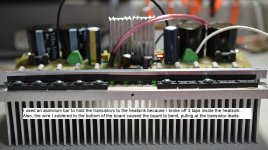 boardonheatsink_side with text.jpg307.1 KB · Views: 144
boardonheatsink_side with text.jpg307.1 KB · Views: 144 -
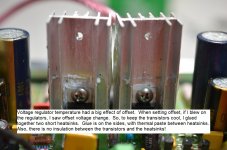 closeup of regulator heatsinks with text.jpg233.6 KB · Views: 136
closeup of regulator heatsinks with text.jpg233.6 KB · Views: 136 -
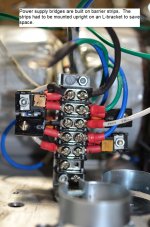 DX Blame bridge rectifier.JPG261 KB · Views: 158
DX Blame bridge rectifier.JPG261 KB · Views: 158 -
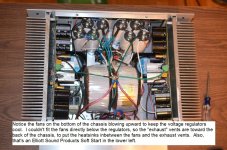 finished DX Blame_smaller with text.jpg346.3 KB · Views: 270
finished DX Blame_smaller with text.jpg346.3 KB · Views: 270 -
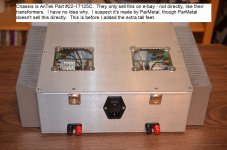 finished DX Blame with text.jpg277.4 KB · Views: 261
finished DX Blame with text.jpg277.4 KB · Views: 261 -
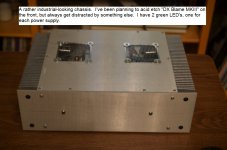 front chassis with text.jpg189.8 KB · Views: 276
front chassis with text.jpg189.8 KB · Views: 276
Bias ...?
Tried 1mv - 28mv across 1 emitter resistor. Parasitic did not change.
Bring it by, i would love to hear it ....
Bring it by where? Are you near Lawrence KS?
Hey woody, it is time to check and reset your prejudices buddy
Mombojumbo is something your people use to say connected to prejudices (or use to be this way) or something that represents a big mess, maybe a huge latine thing ....this may need a revision if i could understand what you meant.
Watch around you.... majority of folks in your place are mixed with latines... also Afro ancestors are near to be majority.... make a revision fellow as you are a minority now a days.
This word looks racist, looks chauvinist, looks something agressive, despicable, degrading, offensive, prejudiced, ironic and hegemonic ...... but i may have misunderstood .... at the end, i do not talk only a little of English ..... each different language have a meaning to these "ironic expressions"
Doctor Self inspired design is never a mess...he is the best wide world ever born electronics audio designer.... if you are able to make something not "mambojumbo" in your evaluation, then post it in our forum and give us the link.
Watch the economics and you will see that Brasil and Mexico is doing fine.
I can send (just gimme an adress) some protude object to put under a bicycle/motorcicle/automobile seat..this may make it soft and dampened, and this sometimes make some critics happy... do not know if you will be a candidate to sit over the damper.... just give me an user adress... the user name can be under secret (not my adress please..heheheheh)
If i am understanding you wrong way (it is always possible)..then do not send me your adress and i will apologize in advance.... at the end.... everybody does mistakes.
Also Brazilian former President loves girls.





Ahahahahahhaah!
Well, it is 04:30 AM...time to go to work to make Brasil even greater...time to stop to have fun and to take a serious destiny...bye!
regards,
Carlos
Mombojumbo is something your people use to say connected to prejudices (or use to be this way) or something that represents a big mess, maybe a huge latine thing ....this may need a revision if i could understand what you meant.
Watch around you.... majority of folks in your place are mixed with latines... also Afro ancestors are near to be majority.... make a revision fellow as you are a minority now a days.
This word looks racist, looks chauvinist, looks something agressive, despicable, degrading, offensive, prejudiced, ironic and hegemonic ...... but i may have misunderstood .... at the end, i do not talk only a little of English ..... each different language have a meaning to these "ironic expressions"
Doctor Self inspired design is never a mess...he is the best wide world ever born electronics audio designer.... if you are able to make something not "mambojumbo" in your evaluation, then post it in our forum and give us the link.
Watch the economics and you will see that Brasil and Mexico is doing fine.
I can send (just gimme an adress) some protude object to put under a bicycle/motorcicle/automobile seat..this may make it soft and dampened, and this sometimes make some critics happy... do not know if you will be a candidate to sit over the damper.... just give me an user adress... the user name can be under secret (not my adress please..heheheheh)
If i am understanding you wrong way (it is always possible)..then do not send me your adress and i will apologize in advance.... at the end.... everybody does mistakes.
Also Brazilian former President loves girls.
Ahahahahahhaah!
Well, it is 04:30 AM...time to go to work to make Brasil even greater...time to stop to have fun and to take a serious destiny...bye!
regards,
Carlos
Attachments
Last edited:
Dx Blame MKIII Hx is a serious amplifier...i have tested and i use to listen to it
Sound wonderfull...it is inspiring and move us to dance.
So, it has the "magic".
By the way, about one guy facing troubles.... reason why i use to ask pictures to see the amplifier is because some guys use huge condensers in the input as they believe this sounds special (only the size, the insulating voltage and the price are special folks)... these parts are big and tune as an aerial some spurious signals we have around us from several sources...... do not think the amplifier is a piece of trash because problems accruing by one or two isolated cases.
This amplifier is very good.
regards,
Carlos
Sound wonderfull...it is inspiring and move us to dance.
So, it has the "magic".
By the way, about one guy facing troubles.... reason why i use to ask pictures to see the amplifier is because some guys use huge condensers in the input as they believe this sounds special (only the size, the insulating voltage and the price are special folks)... these parts are big and tune as an aerial some spurious signals we have around us from several sources...... do not think the amplifier is a piece of trash because problems accruing by one or two isolated cases.
This amplifier is very good.
regards,
Carlos
Attachments
Last edited:
I think the electronic noise on the output is completely inaudible. I'll bet one cannot even measure the noise either....................This amplifier is very good.................
It must be the quietest amplifier ever built !
BTW,
I almost agree with Woody and post1255 just reinforces the observation.
No blame for Blame
Just to be clear. I am reporting what I have found in the course of building and testing my Dx Blame. My hope is to perhaps get some help with the problems I have encountered and to better understand their cause. I am not in any way criticizing the amp or it's designer. Obviously many people have built this amp and are enjoying listening to it. That doesn't mean that their amps are free from the problems I have experienced. The parasitic oscillation I found is outside the range of human hearing and beyond what speakers can reproduce. That's why I asked if anyone else had checked their amp with a scope.
I liked the spirit of this thread when people started the group buy and began building. It would be great if it stayed positive and helpful. We are here to learn and enjoy, No?
Steve
Just to be clear. I am reporting what I have found in the course of building and testing my Dx Blame. My hope is to perhaps get some help with the problems I have encountered and to better understand their cause. I am not in any way criticizing the amp or it's designer. Obviously many people have built this amp and are enjoying listening to it. That doesn't mean that their amps are free from the problems I have experienced. The parasitic oscillation I found is outside the range of human hearing and beyond what speakers can reproduce. That's why I asked if anyone else had checked their amp with a scope.
I liked the spirit of this thread when people started the group buy and began building. It would be great if it stayed positive and helpful. We are here to learn and enjoy, No?
Steve
Yep..... for sure Bonfis
Can you please post pictures of your amplifier...this may help a little to observe if you are using something different than the standard spectation.
Also, can you inform the superimposed oscilation frequency.
I am also learning.
regards,
Carlos
Can you please post pictures of your amplifier...this may help a little to observe if you are using something different than the standard spectation.
Also, can you inform the superimposed oscilation frequency.
I am also learning.
regards,
Carlos
Last edited:
- Status
- Not open for further replies.
- Home
- Amplifiers
- Solid State
- Dx Blame MKIII-Hx - Builder's thread
